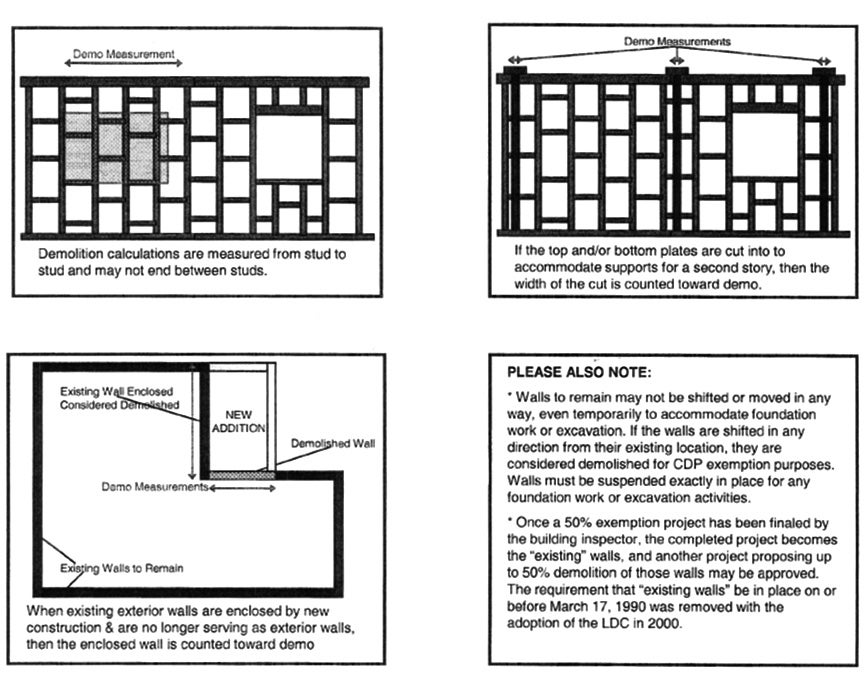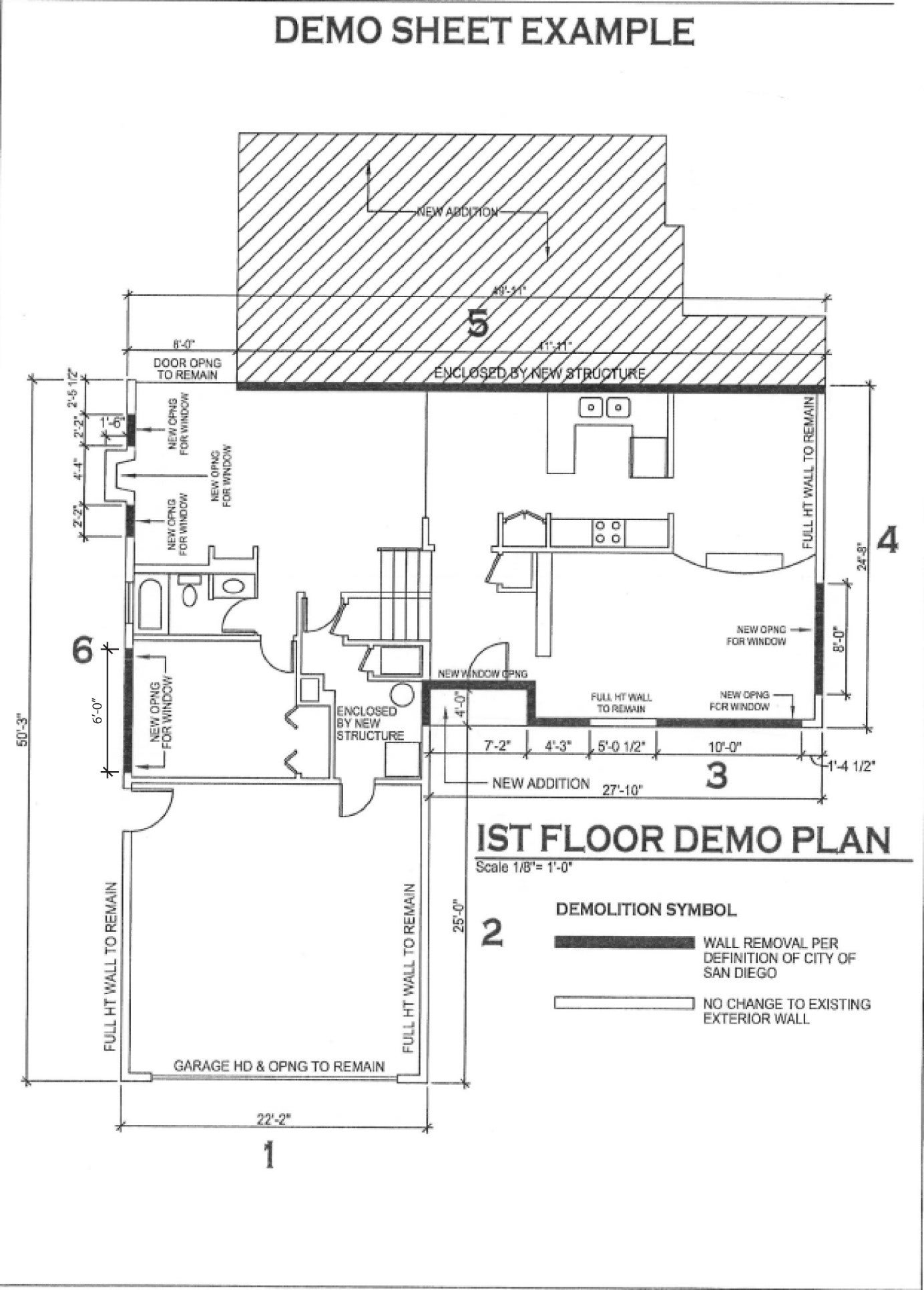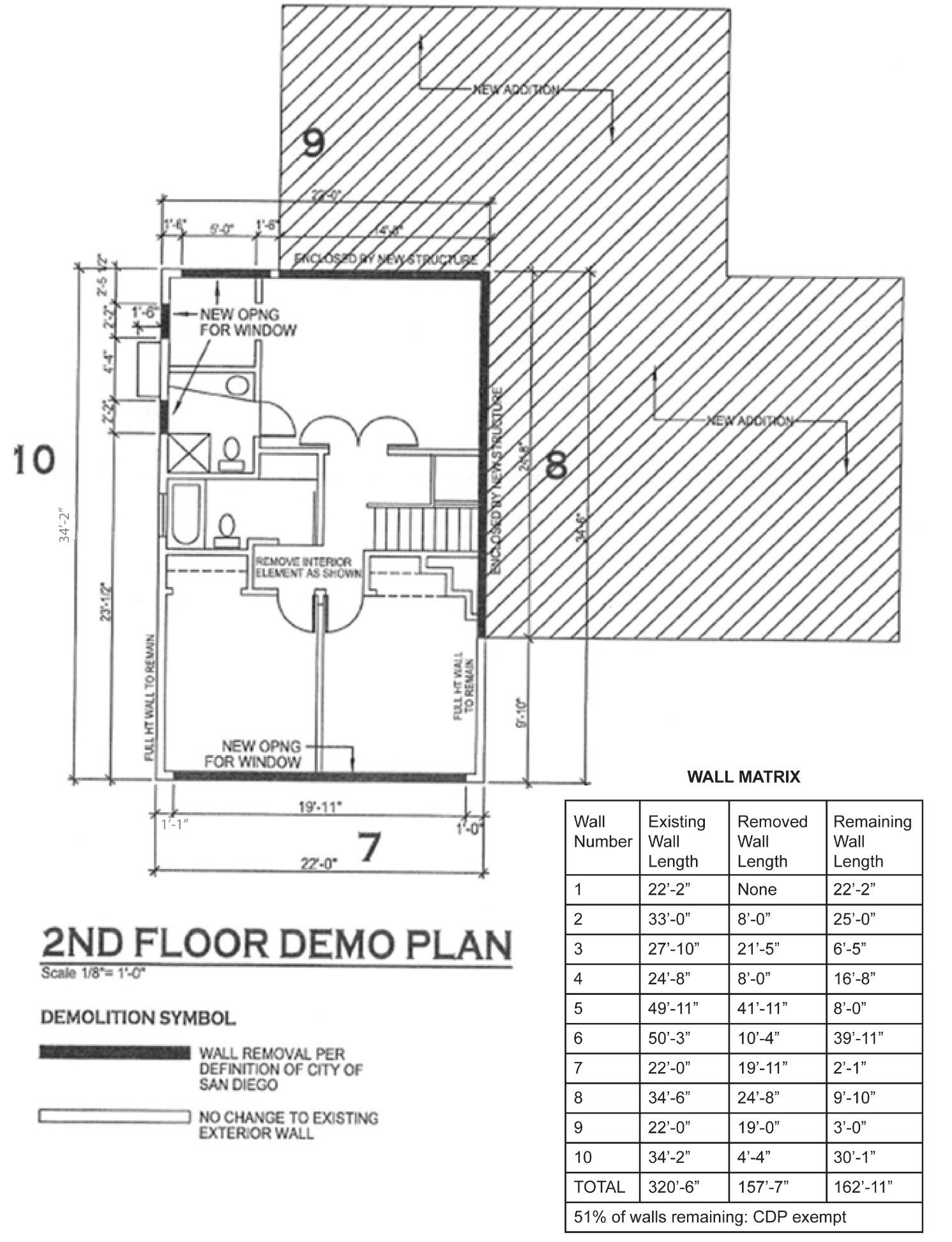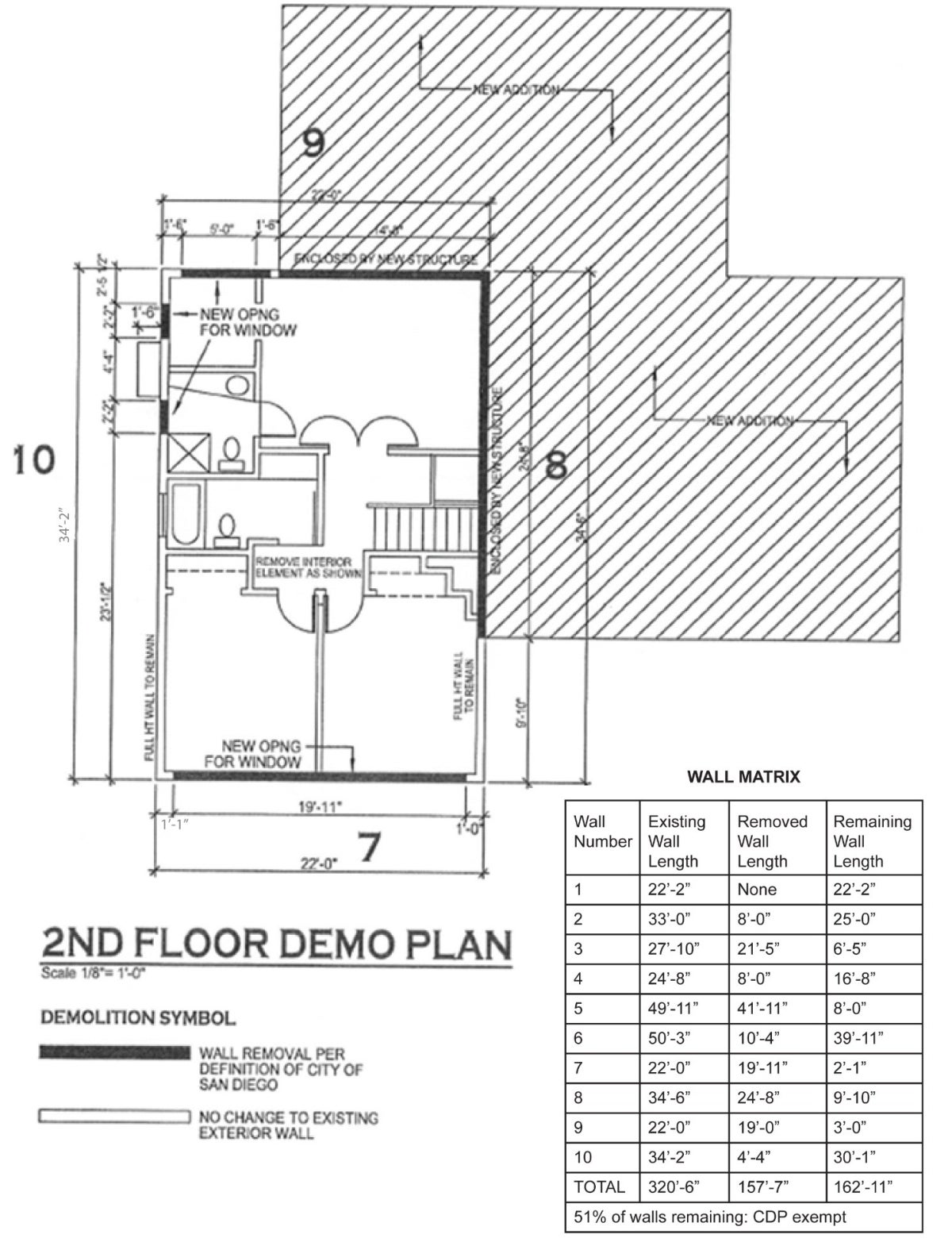How to Calculate Exterior Wall Demolition within the Coastal Overlay Zone
INFORMATION BULLETIN
402
April 2023
IN THIS BULLETIN:
- What is an exterior wall?
- What is not considered an exterior wall?
- How are the exterior walls measured?
- Can minor changes be made to exterior walls that are to remain?
- Can major changes be made to a structure while still maintaining 50% of the walls?
- Can window openings be changed?
- How are fireplaces treated?
- What is required to be included on plans?
- What are the requirements for accessory structures?
- What is a pre-demolition inspection?
- What if termite damage or dry rot is discovered during construction?
- What if 50% or more of the walls are accidentally removed?
- Can I do a phased remodel?
- References
This Information Bulletin provides general information concerning San Diego Municipal Code Section 126.0704(a)(5) and the demolition or removal of 50% or more of the existing exterior walls of existing structures within the Coastal Overlay Zone. This information bulletin describes requirements for conventional framing only, and other construction methods may be viewed in a different method. Many existing structures do not consist of conventional framing, and the information provided in this bulletin may not be entirely applicable to other construction methods, such as single-wall construction or post and pier construction.
There are other regulations within the Coastal Overlay Zone that may require a Coastal Development permit even if 50% or more of the existing exterior walls are not demolished or removed. Please review all of San Diego Municipal Code Section 126.0704 to determine if a Coastal Development Permit is required. For further information or clarification of Coastal Overlay Zone Regulations and the information within this Information Bulletin, please schedule a Virtual Counter appointment at https://www.sandiego.gov/development-services/virtual-appointments.
What is an exterior wall?
An exterior wall consists of the structural elements and/or components of the exterior wall. The structural elements include the top plate, the bottom plate, all studs, and the headers. If a structure consists of more than one story, each story consists of separate exterior walls.
What is not considered an exterior wall?
Any siding, stucco, shear wall or similar covering that may surround an exterior wall is not considered to be a part of the exterior wall and may be removed and replaced without being included in coastal demolition calculations. Any insulation, plumbing or electrical that may be within an exterior wall may be removed, replaced, and/or added without being included in coastal demolition calculations. Cripples, trimmers and windowsills are elements not considered an exterior wall.
The roof, including roof joists, are not part of the exterior wall and can be removed and replaced without being included in coastal demolition calculations.
Any interior wall may be removed and reconfigured without being included in coastal demolition calculations. To be considered an exterior wall, a wall must be exposed to outside air and enclose gross floor area. Walls that enclose basements, underfloor area, wing walls, and/or other similar features that are not considered gross floor area by San Diego Municipal Code Section 113.0234 are not considered exterior walls and are not included in coastal demolition calculations regardless of being partially exposed.
How are the exterior walls measured?
Exterior walls are measured in linear feet on a floor-by-floor basis. Generally, whenever any structural element of a wall is modified, moved, altered, enclosed, or removed, that portion of the wall can be considered demolished and is required to be included in coastal demolition calculations. If an exterior wall is enclosed by a new wall or an addition is constructed to the outside of an exterior wall, then the exterior wall is considered demolished as that exterior wall will no longer be exterior to the building. Walls that are to remain that are shifted or moved in any way, even temporarily, to accommodate foundation or excavation, are considered demolished for coastal demolition purposes.
Can minor changes be made to exterior walls that are to remain?
Reinforcement in the form of sistering members (studs and plates) is allowed. The reinforcement must be to the side or behind the members. If the reinforcement is constructed to the front exterior of those members, then the walls are considered demolished. Penetration through the top plate is permitted, and only the width of the actual cut will be included in the coastal demolition calculation.
For example, only the width of a new four-by-four stud that extends through and above an existing top plate would be counted for coastal demolition purposes. This can be done to allow for new supports for a new top plate. Cripple walls are permitted to be placed on top of existing top plates. Placing a new bottom plate on an existing top plate together with new studs and a new top plate for the purpose of increasing floor-to-ceiling height is allowed. A new wall can be constructed inside and abutting the exterior walls. If the new wall is added to the exterior of a wall that is to remain, then that wall that is to remain is considered demolished for coastal demolition purposes as that existing wall is no longer an exterior wall. New holes for plumbing and/or electrical wiring can be cut into studs or plates without counting the width of the hole as demolition. Plywood for shear purposes may be placed on the exterior walls. If portions of exterior walls are replaced with a “Simpson Strong Wall” product or other similar solution, then those portions of an exterior wall are considered demolished.
Can major changes be made to a structure while still maintaining 50% of the walls?
It is permissible to replace foundations and/or add basements below walls that are to remain or replace entire roof structures if construction activities are able to accommodate that. Interior walls may be removed without any impact on coastal demolition. Exterior walls shall be held in place as a house is remodeled provided a licensed surveyor can verify that the walls have not shifted during construction.
Can window openings be changed?
Many modifications to windows are allowed and not considered to be coastal demolition. Windows that are replaced with new windows of the same size do not result in any demolition as long as the header and king studs are not impacted. A windowsill, including cripples and bottom plate, may be removed to create a larger window or door. Windows can be widened and only the portion of the wall where the king stud previously existed to the end of the new window is included in the calculations.
Coastal Demolition as Applied to Other Wall Modifications

How are fireplaces treated?
If the fireplace penetrates the top plate of the exterior wall, all three sides of the fireplace are considered exterior walls and must be included in the demolition calculations. If the fireplace does not penetrate the top plate of the exterior wall, the fireplace may be removed entirely and will not count toward the demolition calculation.
What is required to be included on plans?
A demolition floor plan is required to be submitted for any project within the Coastal Overlay Zone. Submit a clear, fully dimensioned demolition plan for each floor that shows all walls, windows and door changes, exterior walls enclosed by new construction and areas where top and bottom plates and studs have been removed, changed and/or modified. Include a wall matrix listing all walls in both linear feet and percentages removed and remaining. See the example below.



What are the requirements for accessory structures?
Detached accessory structures may be demolished and/or constructed (not including accessory dwelling units) as allowed by San Diego Municipal Code Section 126.0704(i) and 126.0704(a)(7). Detached accessory structures are not included in demolition calculations for the primary structure. Attached accessory structures are only required to be included in demolition calculations if they contain enclosed space and are included as gross floor area.
What is a pre-demolition inspection?
The Land Development Review - Current Planning reviewer may require a pre-demolition inspection prior to the issuance of the construction permit, depending on the significance of the demolition and/or the proposed project scope. This inspection will occur on the job site. An applicant may also request a pre-demolition inspection. City staff in attendance will include the planner, the senior combination inspector for the area, and the area combination inspector. The applicant team at the inspection should include the architect/designer, contractor, structural engineer (if needed), and/or property owner. During this inspection, a full set of plans, including structural plans, will need to be reviewed and verified for consistency with on-site conditions. The walls will be measured, and the requirements as they relate to coastal demolition will be discussed.
What if termite damage or dry rot is discovered during construction?
If termite damage and/or dry rot is discovered in exterior walls that are to remain, then those walls are still required to remain regardless. It is acceptable to chemically treat the walls in place and sister-damaged members for reinforcement. If the project has been designed with other walls that are to remain, a construction change may be processed to include the demolition of the damaged walls, provided the demolition does not equal or exceed 50% or more.
Due diligence should be performed on the existing structure to determine if there is any dry rot, termite damage or other conditions that impact the structural integrity of specific framing members. Prior to the submittal of a building permit, a No-Plan Building Permit may be necessary to replace framing members prior to utilizing a building permit for a full house remodel.
What if 50% or more of the walls are accidentally removed?
A Coastal Development Permit will be required. Please make sure that all workers on the job site are aware of the requirement to maintain the exterior walls to remain and take steps to secure the site.
Can I do a phased remodel?
Once a 50% exemption project has passed the final inspection by the City combination inspector, the completed project becomes the “existing” walls. A subsequent project proposing less than 50% demolition may be applied to develop the remainder of the structure.
References
- Information Bulletin 118, “How to Process Construction Changes to Permitted Plans”
- Information Bulletin 503, “Fee Schedule for Development Permits/Approvals”
- Information Bulletin 513, “Preliminary Review”
- Project Submittal Manual
- San Diego Municipal Code (SDMC)
- Technical Bulletin BLDG-5-4, “Determination of Building Height in the Coastal Height Limitation Overlay Zone”

